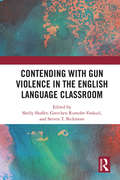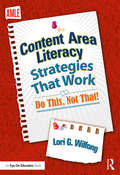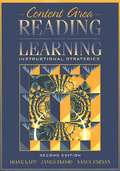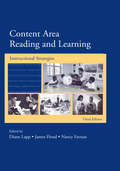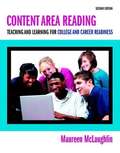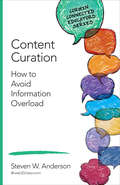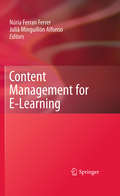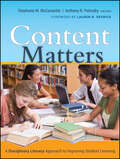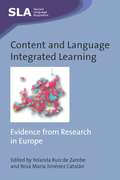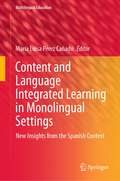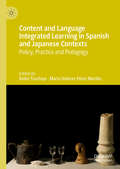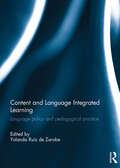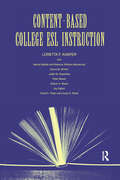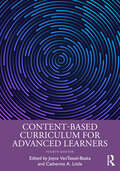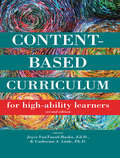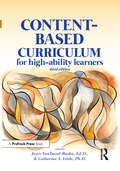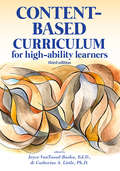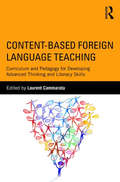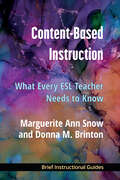- Table View
- List View
Contemporary and Classic Arguments: A Portable Anthology
by Sylvan Barnet Hugo BedauModelling an extensive range of argumentative writing at half the price, the concise Contemporary & Classic Arguments helps you engage with some of today's most pressing topics through a collection of classic essays that provide time-tested models of effective argument.
Contending with Gun Violence in the English Language Classroom
by Shelly Shaffer Gretchen Rumohr-Voskuil Steven T. BickmoreUtilizing experiences and expertise from English educators, young adult literature authors, classroom teachers, and mental health professionals, this book considers how secondary English Language Arts can address school gun violence. Curated by field experts, contributions to this volume pay special attention to how a school’s culture and climate affect how teachers and students communicate around difficult topics that are embedded in the curriculum, but not directly addressed. As the first book that helps teachers and teacher educators to grapple with the topic of school violence specifically in the English education classroom, this book promotes young adult literature and writing activities that address timely and unfortunately recurring events.
Content Area Literacy Strategies That Work: Do This, Not That!
by Lori G. WilfongContent area teachers are now being tasked with incorporating reading and writing instruction, but what works? In this essential book from Routledge and AMLE, author Lori G. Wilfong describes ten best practices for content area literacy and how to implement them in the middle-level classroom. She also points out practices that should be avoided, helping you figure out which ideas to ditch and which to embrace. Topics covered include… Building background knowledge quickly Using specific strategies to scaffold focus while reading Using small group reading strategies to bring personal response and accountability to the content Understanding items that make reading in different disciplines unique Teaching content area vocabulary in meaningful ways Making writing an authentic process through daily and weekly assignments Planning and teaching effective informational and argumentative pieces Each chapter includes Common Core connections and practical templates and tools. The templates are available as free eResources so you can easily print them for classroom use.
Content Area Literacy: An Integrated Approach
by Thomas W. Bean John Readence R. Scott BaldwinThe 10th edition of Content Area Literacy focuses on developing 21st century learners who are adept at reading and critiquing multiple texts. Organized into two parts: Learning with Text and Technology and Teaching and Learning Strategies, this edition has a redesigned page format that provides teachers quick and easy access to concepts, ideas, and strategies.
Content Area Reading and Learning: Instructional Strategies
by James Flood Diane Lapp Nancy FarnanHow can teachers make content-area learning more accessible to their students? This text addresses instructional issues and provides a wealth of classroom strategies to help all middle and secondary teachers effectively enable their students to develop both content concepts and strategies for continued learning. The goal is to help teachers model, through excellent instruction, the importance of lifelong content-area learning. This working textbook provides students maximum interaction with the information, strategies, and examples presented in each chapter. Content Area Reading and Learning: Instructional Strategies, Third Edition is organized around five themes: Content Area Reading: An Overview The Teacher and the Text The Students The Instructional Program School Culture and Environment in Middle and High School Classrooms Pedagogical features: Each chapter includes a graphic organizer, a chapter overview, a Think Before Reading Activity, one or more Think While Reading Activities, and a Think After Reading Activity. The activities present questions and scenarios designed to integrate students’ previous knowledge and experience with their new learnings about issues related to content area reading, literacy, and learning, and to serve as catalysts for thinking and discussions. New in the Third Edition The latest information on literacy strategies in every content area Research-based strategies for teaching students to read informational texts Up-to-date information for differentiating instruction for English-speaking and non-English speaking students An examination of youth culture and the role it plays in student learning A look at authentic learning in contexts related to the world of work Ways of using technology and media literacy to support content learning Suggestions for using writing in every content area to enhance student learning Ideas for using multiple texts for learning content A focus on the assessment-instruction connection Strategies for engaging and motivating students Content Area Reading and Learning: Instructional Strategies, Third Edition, is intended as a primary text for courses on middle and high school content area literacy and learning.
Content Area Reading and Learning: Instructional Strategies (3rd Edition)
by James Flood Diane Lapp Nancy FarnanHow can teachers make content-area learning more accessible to their students? This text addresses instructional issues and provides a wealth of classroom strategies to help all middle and secondary teachers effectively enable their students to develop both content concepts and strategies for continued learning. The goal is to help teachers model, through excellent instruction, the importance of lifelong content-area learning. This working textbook provides students maximum interaction with the information, strategies, and examples presented in each chapter. This book is organized around five themes: Content Area Reading: An Overview The Teacher and the Text The Students The Instructional Program School Culture and Environment in Middle and High School Classrooms. Pedagogical features in each chapter include: a graphic organizer; a chapter overview, Think Before, Think While and Think After Reading Activities - which are designed to integrate students’ previous knowledge and experience with their new learnings about issues related to content area reading, literacy, and learning, and to serve as catalysts for thinking and discussions.This textbook is intended as a primary text for courses on middle and high school content area literacy and learning.
Content Area Reading and Literacy: Succeeding in Today's Diverse Classrooms
by Donna E. Alvermann Victoria R. Gillis George L. BoggsA focus on learning content through discipline-appropriate literacy practices, a strong emphasis on writing, and a current look at the use of media in teaching are hallmarks of the new edition of this widely popular text. Throughout, middle and secondary school teachers get a readable presentation of discipline-appropriate literacy practices and examples and adaptions of selected strategies. Set up to ensure comprehension, the chapters link to the Learning Cycle presented in the beginning of the book, graphic organizers help readers navigate chapter content, and questions, summaries, vignettes, and examples make the concepts clear. This edition of Content Area Reading and Literacy features three full chapters focusing on writing instruction, integrates culture and diversity throughout, and expands or reemphasizes important topics, such as life-long readers and learners beyond the printed text, close and critical reading in discipline-appropriate ways, evidence-based writing, and multimodal texts.
Content Area Reading: Teaching and Learning for College and Career Readiness
by Maureen McLaughlinContent Area Reading: Teaching and Learning for College and Career Readiness
Content Curation: How to Avoid Information Overload (Corwin Connected Educators Series)
by Steven W. AndersonSavvy internet consumption starts right here! Teachers and students are constantly inundated with information, yet lack the organizational skill necessary to effectively utilize it. From Twitter hashtags to online communities, this handy guide will help you to find, store, and share the best information and resources found on the web today—and teach your students to do the same. Real-world tips, tools, in-depth examples and lesson plans help you systematically: Understand the curation process Find, collect, and share reliable web-based information Build students’ information literacy skills Help students research and organize problem-based learning projects Use cutting-edge curation tools like Evernote, Diigo, and Pocket The Corwin Connected Educators series is your key to unlocking the greatest resource available to all educators: other educators. Being a Connected Educator is more than a set of actions: it’s a belief in the potential of technology to fuel lifelong learning. "Speaking from his own experience and perspectives as a learner, teacher, and educational leader, Steven Anderson brings clarity to a process that can be difficult and overwhelming. Steven offers tried and tested strategies and tools for evaluating, organizing, and sharing the vast amount of online content educators and students have at their fingertips. If you′re drowning in digital content, this book is your life jacket. " —Jayme Linton, Assistant Professor of Education Lenoir-Rhyne University, Hickory, NC
Content Curation: How to Avoid Information Overload (Corwin Connected Educators Series)
by Steven W. AndersonSavvy internet consumption starts right here! Teachers and students are constantly inundated with information, yet lack the organizational skill necessary to effectively utilize it. From Twitter hashtags to online communities, this handy guide will help you to find, store, and share the best information and resources found on the web today—and teach your students to do the same. Real-world tips, tools, in-depth examples and lesson plans help you systematically: Understand the curation process Find, collect, and share reliable web-based information Build students’ information literacy skills Help students research and organize problem-based learning projects Use cutting-edge curation tools like Evernote, Diigo, and Pocket The Corwin Connected Educators series is your key to unlocking the greatest resource available to all educators: other educators. Being a Connected Educator is more than a set of actions: it’s a belief in the potential of technology to fuel lifelong learning. "Speaking from his own experience and perspectives as a learner, teacher, and educational leader, Steven Anderson brings clarity to a process that can be difficult and overwhelming. Steven offers tried and tested strategies and tools for evaluating, organizing, and sharing the vast amount of online content educators and students have at their fingertips. If you′re drowning in digital content, this book is your life jacket. " —Jayme Linton, Assistant Professor of Education Lenoir-Rhyne University, Hickory, NC
Content Management for E-Learning
by Julià Minguillón Alfonso Núria Ferran FerrerThe increasing growth in the use of e-learning environments, in which education is delivered and supported through information and communication technologies, has brought new challenges to academic institutions. From all the current definitions of e-learning, it can be seen that learning contents are one of the key issues for a successful e-learning experience. Therefore, there is a real need for academic staff, managers and librarians to re-think the whole process of delivering courses, information resources and information services. The book focuses on defining content management and its relationship with knowledge management, providing perspectives on how the semantic web could complement content management, how to deal with copyright restrictions, and how to describe information competencies and skills required and acquired by teachers and students in virtual environments. Offered is a design project for managing digital content for classical and distance education institutions, covering all the aspects related to the content lifecycle, integrating it into the learning process. Practical aspects such as standards for content e-learning management, a review of existing experiences of learning repositories, and a survey of available platforms for delivering courses and providing access to information resources is also covered. Lastly, the book addresses the three main factors which make it crucial in the current context: first, the web 2.0 paradigm, which breaks the content producer-consumer barrier; second, the open content movement for educational purposes, which changes the knowledge management transference model; and third, the new European Higher Education Area, where the concept of content needs to be rethought.
Content Matters: A Disciplinary Literacy Approach to Improving Student Learning
by Stephanie M. Mcconachie Anthony R. Petrosky Lauren B. ResnickAn authoritative guide for improving teaching, learning, and literacy in content area classrooms This book introduces teachers to the Disciplinary Literacy instructional framework developed by the Institute for Learning, University of Pittsburgh. Grounded in the Principles of Learning developed by acclaimed educator Lauren Resnick, the framework is designed to prepare students, grades 6 and up, to master the rigorous academic content learning required for college success. Unlike 'generic' teaching models, the framework is specifically tailored for each of the content disciplines. Highly practical, the book shows teachers how to integrate literacy development and thinking practices into their routine content instruction, with separate chapters devoted to math, science, history, and English/language arts. The book also shows how school instructional leaders can support teachers in learning and using this instructional approach. Offers an innovative approach for improving literacy, thinking, and content learning in secondary students Includes detailed instructional guidance plus numerous classroom examples of lessons, dialogs, and teaching routines Features chapters on each of the content areas-math, science, language arts, and social sciences Provides leadership guidance in implementing the method Foreword written by internationally acclaimed educator and cognitive scientist Lauren Resnick
Content and Language Integrated Learning
by Rosa Maria Jimenez Catalan Yolanda Ruiz de ZarobeThis book contributes to the growth of interest in Content and Language Integrated Learning (CLIL), an approach to second/foreign language learning that requires the use of the target language to learn content. Within the framework of European strategies to promote multilingualism, CLIL has begun to be used extensively in a variety of language learning contexts, and at different educational systems and language programmes. This book brings together critical analyses on theoretical and implementation issues of Content and Language Integrated Learning, and empirical studies on the effectiveness of this type of instruction on learners' language competence. The basic theoretical assumption behind this book is that through successful use of the language to learn content, learners will develop their language proficiency more effectively while they learn the academic content specified in the curricula.
Content and Language Integrated Learning in Monolingual Settings: New Insights from the Spanish Context (Multilingual Education #38)
by María Luisa Pérez CañadoThis book offers new empirical insights into the current state of Content and Language Integrated Learning (CLIL) characterisation (through an innovative proposal to link CLIL to English as a Lingua Franca), implementation (via observation protocols and SWOT analyses), and research (by examining the effects of CLIL on the L1, foreign language, key competences, and content subjects taught through English). The book provides a state of the art of the CLIL arena, identifies the chief challenges that need to be addressed and signposts possible ways of overcoming these in order to continue advancing smoothly into the next decade of CLIL development. This book will be of interest to researchers, policy-makers, educational authorities, and practitioners as it will assist them in making informed decisions about how to characterise, implement, and investigate CLIL in the bi- and plurilingual programs that are more frequently introduced in monolingual contexts.
Content and Language Integrated Learning in South America (Multilingual Education #46)
by Yolanda Ruiz de Zarobe Darío Luis BanegasCLIL is a pedagogical approach which has gained traction in different educational and geographical contexts as a key tool in language learning and teaching. After more than 25 years of implementation, we can assert that we have learned a great deal about what CLIL entails. However, it is also true that we still need to contextualise the approach in order to clearly delimit what CLIL has to offer in each setting. This is precisely the aim of this book. This volume focuses on CLIL in South American contexts. It identifies, clarifies and offers insights into issues related to its characterisation and implementation, as well as teacher education. With contributions from a prestigious array of scholars and practitioners from various parts of South America, it also highlights some of the achievements and challenges in the process of implementing CLIL in the region. Against the backdrop of South American contexts, this book aims to provide a useful and innovative lens through which policy makers, researchers and teachers will find significant implications for the development of CLIL.
Content and Language Integrated Learning in Spanish and Japanese Contexts: Policy, Practice and Pedagogy
by Keiko Tsuchiya María Dolores Pérez MurilloThis edited book compiles pedagogical practices and studies of Content and Language Integrated Learning (CLIL) from two sites: Spain, where CLIL has been widely implemented for more than a decade, and Japan, where the CLIL approach is still in its relative infancy, and quickly gaining momentum. Focusing on three aspects of the CLIL implementations: policy, practice and pedagogy, the authors describe how CLIL has evolved in distinctive socio-political, historical and cultural contexts. The chapters range across primary, secondary and tertiary education, and examine English language teaching and learning at both the macro level - through language education policy - and the micro level - with a focus on classroom interaction and pedagogy. This book fills a gap in the English as a Medium of Instruction (EMI) literature, and will be of particular interest to language teachers, teacher trainers, and students and scholars of applied linguistics more broadly.
Content and Language Integrated Learning: Language Policy and Pedagogical Practice (Second Language Acquisition Ser.)
by Yolanda Ruiz de ZarobeThis book explores some of the recent research undertaken on Content and Language Integrated Learning (CLIL). It offers an overview of several European contexts, describing experiences that could be extrapolated to many other communities worldwide. Contributions focus on issues related to language policy, moving from high-level policymaking to grassroots decisions, but all of them encompassing the major changes that can be recognized in education, which also evidence the shifts in society and economic life that have taken place in Europe in the last decades. These changes in language policy issues are coupled with changes in CLIL practice in the classroom. These national initiatives are displayed across a wide range of educational perspectives, portraying the diversity that is a distinctive feature of CLIL in the European educational mosaic. By providing new insights into pedagogic, methodological, and language policy issues in CLIL, and by covering some areas which have been insufficiently addressed in the literature, such as the implementation of CLIL in ‘less successful’ contexts, or learner-teacher collaboration in the classroom, this book will be of great value to researchers, stakeholders and professionals interested in CLIL and language education. This book was originally published as a special issue of the International Journal of Bilingual Education and Bilingualism.
Content-Area Writing: Every Teacher's Guide
by Harvey Daniels Steven Zemelman Nancy SteinekeThere are three truths about teaching writing, one that's widely known, one that isn't, and one that will change your teaching forever: the ability to write is essential for students in every subject area writing is the most powerful and efficient tool that teachers have for helping students connect with content and deepen their understanding of it every teacher, including you, is ready to coach middle and secondary writers successfully right now. No matter what subject you teach, Content-Area Writing is for you, especially if you're juggling broad curriculum mandates, thick textbooks, and severe time constraints. It not only shows that incorporating carefully structured writing activities into your lessons actually increases understanding and achievement, but also proves how writing can save, not consume, valuable instructional time. Following up on Subjects Matter - the book that changed how tens of thousands of language arts, math, science, and social studies teachers use reading in their classrooms - Harvey Daniels, Steven Zemelman, and Nancy Steineke now present the most thorough and practical exploration available of writing in the subject areas. Content-Area Writing guides you strategically through the two major types of writing that every student must know: Writing to Learn: the quick, exploratory, and extemporaneous in-class writing that helps kids engage deeply with content, build connections, and retain what they've learned, Public Writing: planned, constructed, and polished writing in which students demonstrate knowledge and reflect on what they've learned. With their contagious combination of humor, irreverence, and classroom smarts, Daniels, Zemelman, and Steineke give you dozens of valuable lessons for encouraging growth in both types of writing with subject-specific ideas for planning, organizing, and teaching, as well as samples of student work and guidelines for evaluation and assessment. They also include detailed information on how their strategies fit into the writing process, how they can be used in writing workshops across the curriculum, and how they prepare students for testing and other on-demand writing situations. With writing, you can help students learn better, retain more, meet content- and skills-based standards, and tackle any test with confidence. No matter what you teach, read Content-Area Writing and discover for yourself that classroom time spent writing is classroom time well spent.
Content-Based College ESL Instruction
by Donna M. Brinton Loretta F. Kasper Marcia Babbitt Rebecca William Mlynarczyk Judith W. RosenthalThis book is carefully designed to inform and train readers in the techniques of content-based ESL instruction and to assist them in developing and implementing content-based materials and programs appropriate to their educational institutions and situations. Every chapter presents a balance of theory and practice, focusing on a detailed description, with clear examples of classroom practices including information, suggestions, and instructional tools. Each chapter addresses assessment issues as they apply to the particular methodology described.
Content-Based Curriculum for Advanced Learners
by Joyce VanTassel-Baska and Catherine A. LittleThe fourth edition of Content-Based Curriculum for High-Ability Learners provides readers with a complete and up-to-date introduction to core elements of curriculum development in gifted education with implications for school-based implementation. Written by key experts in the field, this text is essential to the development of high-powered, rich, and complex curricula that treat content, process, product, and concept development considerations as equal partners in the task of educating gifted learners. Along with revised chapters, this edition contains new chapters on culturally responsive curriculum, the performing arts, robotics, and engineering design, as well as social and emotional learning. Additional material concerning talent trajectories across the lifespan accompanies a discussion of honors curriculum in higher education, rounding out this comprehensive resource. This master text is a must read for educators interested in executing effective curriculum and instructional interventions to support learning for gifted and advanced learners.
Content-Based Curriculum for High-Ability Learners
by Joyce Vantassel-Baska Catherine A. LittleThe newly updated "Content-Based Curriculum for High-Ability Learners" provides a solid introduction to curriculum development in gifted and talented education. Written by experts in the field of gifted education, this text uses cutting-edge curriculum design techniques and aligns the core content with national and state standards. In addition to a revision of the original chapters, the second edition contains new chapters on topics such as second language learning, leadership, arts curriculum, and technology.
Content-Based Curriculum for High-Ability Learners
by Joyce VanTassel-Baska Ed.D;Ph.DContent-Based Curriculum for High-Ability Learners (3rd ed.) provides a solid introduction to core elements of curriculum development in gifted education and implications for school-based implementation. Written by experts in the field, this text uses cutting-edge design techniques and aligns core content with national and state standards. In addition to revised chapters, the third edition contains new chapters on topics including special populations of gifted learners, critical thinking, leadership, and university-level honors curriculum.The text identifies fundamental principles of curriculum that support advanced and high-potential learners: accelerated learning within the core content areas, use of higher order processes and products, and concept development. These emphases form threads across chapters in core content areas, including language arts, mathematics, science, social studies, world languages, and the arts. Additional chapters explore structures to support implementation, including alignment with standards, assessment of learning, counseling, and promoting exemplary teacher practice through professional development.
Content-Based Curriculum for High-Ability Learners (Other Ser.)
by Joyce Vantassel-Baska Catherine LittleContent-Based Curriculum for High-Ability Learners (3rd ed.) provides a solid introduction to core elements of curriculum development in gifted education and implications for school-based implementation. Written by experts in the field, this text uses cutting-edge design techniques and aligns core content with national and state standards. In addition to revised chapters, the third edition contains new chapters on topics including special populations of gifted learners, critical thinking, leadership, and university-level honors curriculum. The text identifies fundamental principles of curriculum that supports advanced and high-potential learners: accelerated learning within the core content areas, use of higher order processes and products, and concept development. These emphases form threads across chapters in core content areas including language arts, mathematics, science, social studies, world languages, and the arts. Additional chapters explore structures to support implementation, including alignment with standards, assessment of learning, counseling, and promoting exemplary teacher practice through professional development.
Content-Based Foreign Language Teaching: Curriculum and Pedagogy for Developing Advanced Thinking and Literacy Skills
by Laurent CammarataPushing the field forward in critically important ways, this book offers clear curricular directions and pedagogical guidelines to transform foreign language classrooms into environments where stimulating intellectual curiosity and tapping critical thinking abilities are as important as developing students’ linguistic repertoires. The case is made for content-based instruction—an approach to making FL classrooms sites where intellectually stimulating explorations are the norm rather than the exception. The book explicitly describes in detail how teachers could and should use content-based instruction, explains how integration of content and language aims can be accomplished within a program, identifies essential strategies to support this curricular and pedagogical approach, discusses issues of assessment within this context, and more. Content-Based Foreign Language Teaching provides theoretical perspectives and empirical evidence for reforming curricula and instruction, describes models and curriculum planning strategies that support implementation of well-balanced FL programs, explores the transformative potential of critical pedagogy in the FL classroom, and offers illustrations of secondary and post-secondary language programs that have experimented with alternative approaches. Advancing alternatives to conventional curriculum design, this volume posits meaning-oriented approaches as necessary to create language programs that make a great difference in the overall educational lives of learners
Content-Based Instruction: What Every ESL Teacher Needs to Know
by Marguerite Ann Snow Donna M. Brinton“CBI is a highly flexible approach that provides a powerful means of structuring the syllabus for both general purpose and EAP courses." ?---Marguerite Ann Snow and Donna M. Brinton In this e-single, Snow and Brinton, editors of the Second Edition of The Content-Based Classroom: New Perspectives on Integrating Language and Content (2017), explain how “content-based instruction (CBI) is a vibrant approach to curriculum design that is able to ‘flex’ to fit a wide variety of student populations, settings, and program goals.” The ebook introduces readers to the concept of CBI through a brief history and countless examples of many ways this approach can be applied across settings and programs. Whether readers want to deepen their understanding of CBI or get ideas for their own teaching situation, this book provides: * an overview of CBI, including the three prototype models (theme-based, sheltered, adjunct) * a discussion of new models: sustained content language teaching, content and language-integrated learning, English-medium instruction, adjunct models, and other hybrid models * a rationale for CBI, including support from SLA and other research * an examination of issues that arise in implementation * a research agenda for CBI * further readings. Each section includes reflection questions designed to guide readers to consider how best to implement CBI in their course and program.

